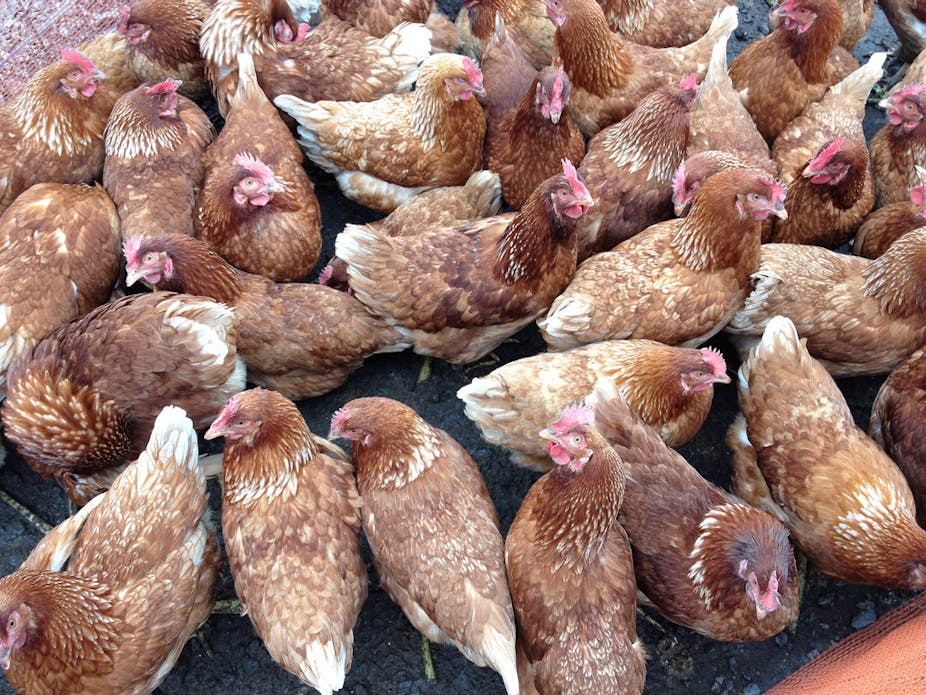For the animal industry and the animal protection movement, the Australian Competition and Consumer Commission’s (ACCC) pending case against poultry producer Steggles is set to be their very own version of the OJ Simpson trials – absolutely gripping!
Under examination are claims made by Steggles, in an advertising campaign they funded and approved, that broiler chickens are “free to roam”. In response, the “ACCC alleges that the population density of meat chickens raised in barns preclude such movement”.
The chickens we eat are typically referred to as broiler chickens. This differentiates them from egg-laying hens. Broiler chickens live in large sheds and face a number of serious welfare problems.
Broiler chickens are typically fully grown by six weeks. The result of their accelerated growth is that many birds suffer under the weight of their large body mass. Serious skeletal problems are not uncommon.
But while the raising of broiler chickens is not uncontroversial from an animal welfare perspective, it is nonetheless true that they do not live in cages. That is, they do not live in battery cages, which is the cage system used in the commercial egg industry. But just because they don’t live in cages, does that mean they are “free to roam”? The ACCC doesn’t think so and apparently Federal Court judge Richard Tracey also has his doubts.
In opening submissions Justice Tracey was quoted as saying: “Five hundred square centimetres is a very small part of this world … Does it not follow mathematically that if some birds are to have a larger amount of space in which to move around, the others in the shed are going to be even closer together?”.
You see, while a typical broiler shed may be relatively spacious on day one, when the chicks are very small, by day 30 these are cramped environments. Moreover, the birds have to spend considerable time trying to access food and water. It’s no mean feat when you share a trough with around 30,000 others.
As someone who has spent time inside a broiler shed as a member of the NSW Animal Research Review Panel, I’m not surprised by the revelations coming out of the Steggles case.
What has got me aghast is that this scrutiny, and the cost and stress associated with facing Federal Court, was all brought upon Steggles by themselves. If they had just kept their mouths shut and said nothing they could have continued growing chicken meat any way they liked and no one would have been any wiser.
Given this incredible turn of events, two questions come quickly to mind: why did they decide to invite such scrutiny? And how could they possibly have thought that anyone would equate 18 birds per square metre with a capacity to “roam”? They should have asked me. I could have told them that it simply wouldn’t wash.
In research I undertook for my PhD at the University of Sydney, and subsequently published in my book Animals, Equality and Democracy, I demonstrate that the more the community is aware of animal suffering the more likely they are to insist on stronger animal protection laws. This means that high-visibility animal uses, such as animals in zoos, tend to attract stronger animal welfare laws than low-visibility animal uses, such as factory farming.
As Emeritus Professor of animal agriculture, Peter R. Cheeke argues, “one of the best things modern animal agriculture has going for it is that most people in the developed countries are several generations removed from the farm and haven’t a clue how animals are raised and ‘processed’”.
So that returns us to the puzzling matter of Steggles and why they thought they could describe broiler chickens as “free to roam”. Maybe they assumed that because most people will never see inside a broiler shed the public would not know the difference.
While that analysis may be partially true, it doesn’t take into account the growing influence and professionalism of animal protection organisations. For example, Sydney-based Voiceless has its own in-house legal team and was one of a number of agencies to make a complaint against Steggles to the ACCC. Is Steggles unaware of the growing professionalism among animal advocates?
We will never know what discussions took place in the lead up to the ill-fated “free to roam” advertising campaign. But, I for one, will be watching carefully for media reports about the court case. I also anticipate that by its close the broader community will know a whole lot more about how chickens are raised for meat – probably more than Steggles would like you to know.

